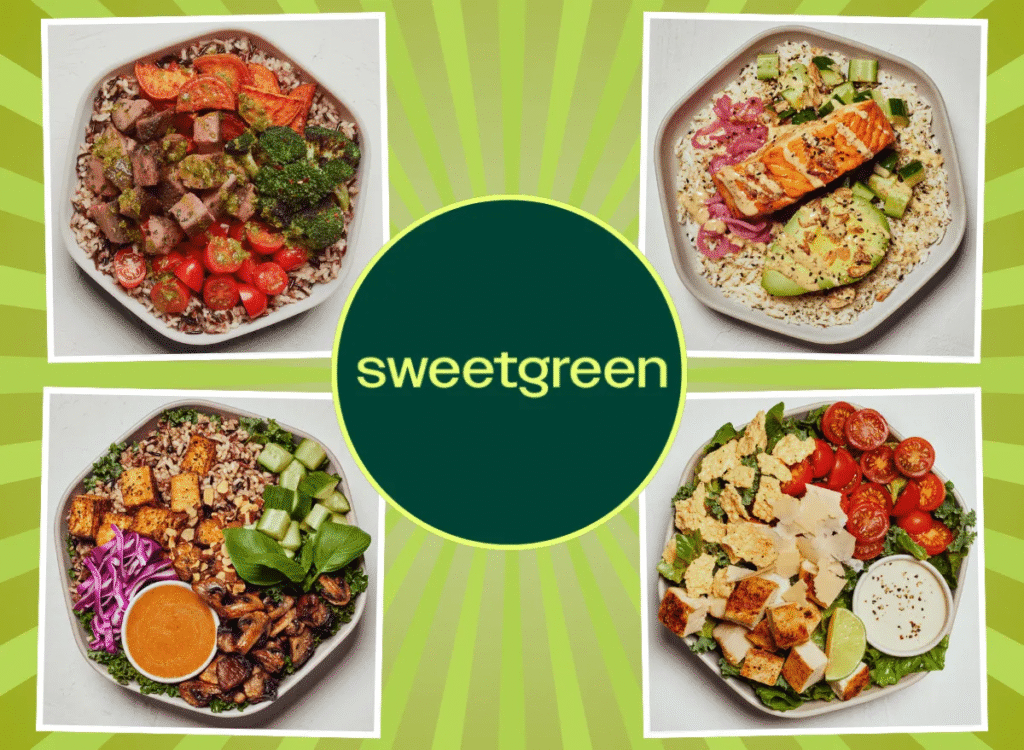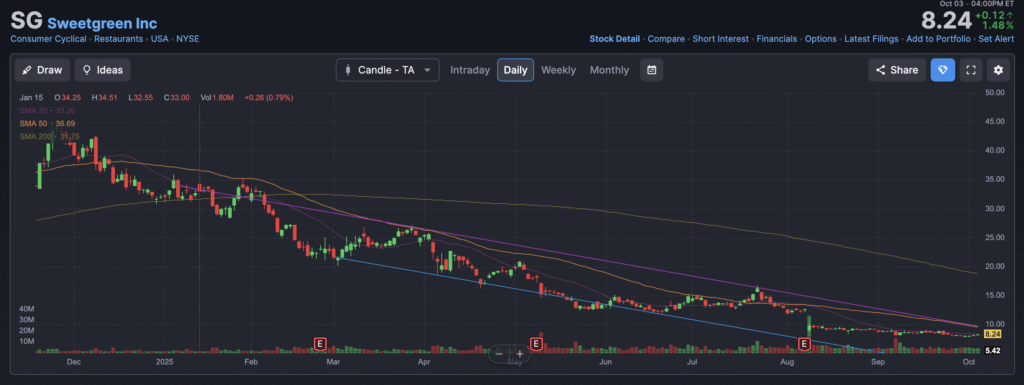Sweetgreen, Inc. is an American fast-casual restaurant company specializing in healthy salads and grain bowls. Founded in 2007 and headquartered in Los Angeles, it operates over 240 locations across the United States, focusing on fresh, locally sourced ingredients and digital-first ordering. The company’s 2024 revenues were approximately $677 million, reflecting double-digit growth as it continues expanding its footprint. Sweetgreen competes primarily with Cava, Chipotle Mexican Grill, and Just Salad in the rapidly growing “better-for-you” dining market. Its focus on technology and sustainability has positioned it as a premium choice in the health-conscious food category.

Sweetgreen reported its most recent earnings on August 7, 2025, for the second quarter of fiscal year 2025. Revenue came in at $185.6 million, representing roughly 0.5% year-over-year growth, below analyst expectations of about $190 million. The company posted a net loss of $23.2 million, or an EPS of –$0.20, compared with a loss of $0.19 per share a year ago. Comparable store sales declined 7.6% year-over-year, driven mainly by a 10.1% decrease in traffic, partially offset by menu price increases. Sweetgreen guided full-year 2025 revenue between $700 and $715 million, with adjusted EBITDA expected between $10 and $15 million and restaurant-level margins near 17.5%.
In segment terms, Sweetgreen operates one reportable segment — its company-operated restaurants — but internally tracks results by geography and restaurant class. The brand’s core revenue drivers are its urban locations, which continue to outperform suburban stores on average unit volume. Digital orders, which make up more than 60% of total sales, remain a strong component of its revenue mix. Sweetgreen has also started rolling out “Infinite Kitchen” stores — automated assembly restaurants that use robotics to prepare bowls — designed to improve throughput and reduce labor costs, which should eventually lift unit economics. These stores represent a major part of Sweetgreen’s long-term margin expansion strategy.
Looking ahead, management expects near-term headwinds in same-store traffic but believes growth will reaccelerate in 2026 as new store formats mature. The company reaffirmed its commitment to open more than 40 net new restaurants this year, with 20 expected to feature Infinite Kitchen technology. Its 2025 full-year guidance reflects modest same-store sales declines of 4% to 6%, signaling short-term caution. However, by 2026, Sweetgreen anticipates improved consumer trends and incremental margin gains from automation, digital loyalty, and supply-chain optimization. The company expects adjusted EBITDA profitability to continue improving sequentially each quarter.
Sweetgreen’s stock performance in 2025 has been volatile. Year-to-date, the stock has fallen roughly 25% as investors reacted to weaker traffic trends and negative earnings revisions. After the August 2025 earnings release, shares dropped more than 10% in after-hours trading as revenue and comparable sales missed expectations. Despite this short-term decline, the company’s automation narrative continues to attract longer-term investors looking for scalable efficiency plays in the restaurant space. The stock has recovered slightly since September as analysts weighed potential operating leverage in 2026.
Immediately after the earnings release, Sweetgreen’s stock fell sharply in extended trading. The weak same-store sales and modest guidance revision led to broad analyst downgrades and cautious commentary across Wall Street. While management reiterated its confidence in the Infinite Kitchen rollout, the near-term profitability timeline was pushed back, frustrating investors who had anticipated quicker breakeven progress. The sell-off underscored market skepticism about consumer demand trends and the brand’s ability to sustain premium pricing in a slowing macro environment. Over the following week, the stock stabilized around the mid-$8 range.
In the second quarter of 2025, Sweetgreen generated $185.6 million in revenue, up slightly from $184.5 million in the year-ago period. Net loss widened modestly to $23.2 million from $22.1 million in Q2 2024, with EPS of –$0.20 versus –$0.19 previously. Comparable restaurant sales declined 7.6%, largely due to lower traffic. Adjusted EBITDA fell to $6.4 million from $12.4 million last year, highlighting margin compression amid rising operating costs. Despite these challenges, the company achieved record operational efficiency in its first two fully automated stores, supporting its long-term investment thesis.
Revenue by segment continues to be driven by company-operated restaurants, which make up nearly all total sales. Digital and app-based channels represent more than half of revenue, driven by convenience, loyalty programs, and direct ordering incentives. Catering and delivery partnerships contribute a smaller but growing share of sales, while the Infinite Kitchen units are expected to significantly expand their contribution over the next two years. The company also continues testing menu innovation, including warm bowls, proteins, and seasonal offerings, to broaden its appeal beyond its core salad customer base.
Founded in 2007 by Georgetown University graduates Jonathan Neman, Nicolas Jammet, and Nathaniel Ru, Sweetgreen began as a single shop near campus with the goal of providing accessible, healthy meals. It quickly grew through a mix of private investment and venture capital, attracting notable backers like Revolution Growth, Fidelity, and D1 Capital Partners. Sweetgreen went public in November 2021, raising over $360 million in its IPO. The company is headquartered in Los Angeles, California, with satellite offices for operations and marketing in New York and Washington, D.C. Its key competitors include Cava, Just Salad, Dig, and Chipotle Mexican Grill.
The market Sweetgreen operates in — fast-casual, health-oriented dining — is projected to grow steadily through 2030, driven by consumer demand for convenient, fresh, and plant-forward meals. Analysts estimate the U.S. healthy fast-casual segment could reach over $150 billion by 2030, with a compound annual growth rate (CAGR) between 6% and 8%. Growth is expected to be strongest in suburban expansion, drive-thru formats, and digitally enabled restaurants. Sweetgreen’s positioning at the intersection of technology, health, and sustainability aligns well with long-term consumer trends, even though near-term macro conditions have dampened discretionary dining spending.
Competitors in this market range from category leaders like Chipotle, which combines operational scale with efficiency, to rapidly growing peers like Cava, which has achieved higher average unit volumes and comparable store sales growth. Just Salad and Dig Inn also compete in key metro markets, targeting similar customers seeking customizable, nutritious meals. Sweetgreen’s challenge lies in differentiating its premium pricing and experience amid intensifying competition and overlapping menus. However, its early embrace of technology and automation could become a long-term moat if it delivers consistent results.
Sweetgreen’s unique differentiation lies in its integration of sustainability, technology, and brand ethos. The company’s Infinite Kitchen initiative represents a clear bet on automation to enhance margins and throughput. Its brand equity around freshness and local sourcing gives it authenticity unmatched by most fast-casual peers. Digital sales exceeding 60% of total revenue provide valuable customer data and margin advantages over traditional restaurant models. Furthermore, Sweetgreen’s emphasis on lifestyle marketing and community engagement — positioning itself as a movement rather than merely a restaurant chain — has created strong brand loyalty among millennials and Gen Z consumers.
Sweetgreen’s management team remains founder-led, preserving a consistent vision since inception. CEO Jonathan Neman oversees strategic growth and investor relations, while co-founder Nicolas Jammet leads brand and culinary direction. Nathaniel Ru heads development and innovation initiatives, including the rollout of Infinite Kitchen locations. This leadership trio has maintained operational cohesion through years of rapid expansion, though some investors continue to press for the addition of experienced executives with deep restaurant scaling expertise to complement the founders’ vision.
Financially, Sweetgreen has grown revenues at a compounded annual rate of roughly 15% over the past five years, from under $400 million in 2019 to nearly $677 million in 2024. Despite strong top-line growth, the company has yet to achieve GAAP profitability, recording a net loss of approximately $90 million in 2024. Adjusted EBITDA margins, however, have improved gradually, signaling progress toward operational leverage. The company’s balance sheet remains strong, supported by IPO proceeds and disciplined capital management, though cash burn persists due to new store openings and technology investments.
Earnings growth has been constrained by inflationary pressures, high labor costs, and slower-than-expected throughput recovery post-pandemic. Nonetheless, Sweetgreen’s automation push and expansion into lower-cost suburban markets could help unlock margin improvement. Restaurant-level margins are expected to climb toward 20% by 2026 as Infinite Kitchen units scale. Overall, the company remains in a transition phase from top-line growth to sustainable profitability, with the success of its automation rollout serving as the key catalyst for future earnings expansion.
The bull case for Sweetgreen centers on its ability to successfully scale automation, deliver consistent traffic growth, and achieve sustainable margins. If Infinite Kitchen technology materially lowers labor costs and increases throughput, unit economics could rival Chipotle’s within several years.
The bear case focuses on consumer price sensitivity, traffic declines, and execution risk in scaling automation across multiple store formats, which could delay profitability and constrain cash flow.

The stock is in a long term stage 4 markdown (bearish) area on the weekly chart and the daily chart is in consolidation stage 1 between $8 and $10. It should be there for the near term with not an easy reversal soon. We wont be touching this stock for now.